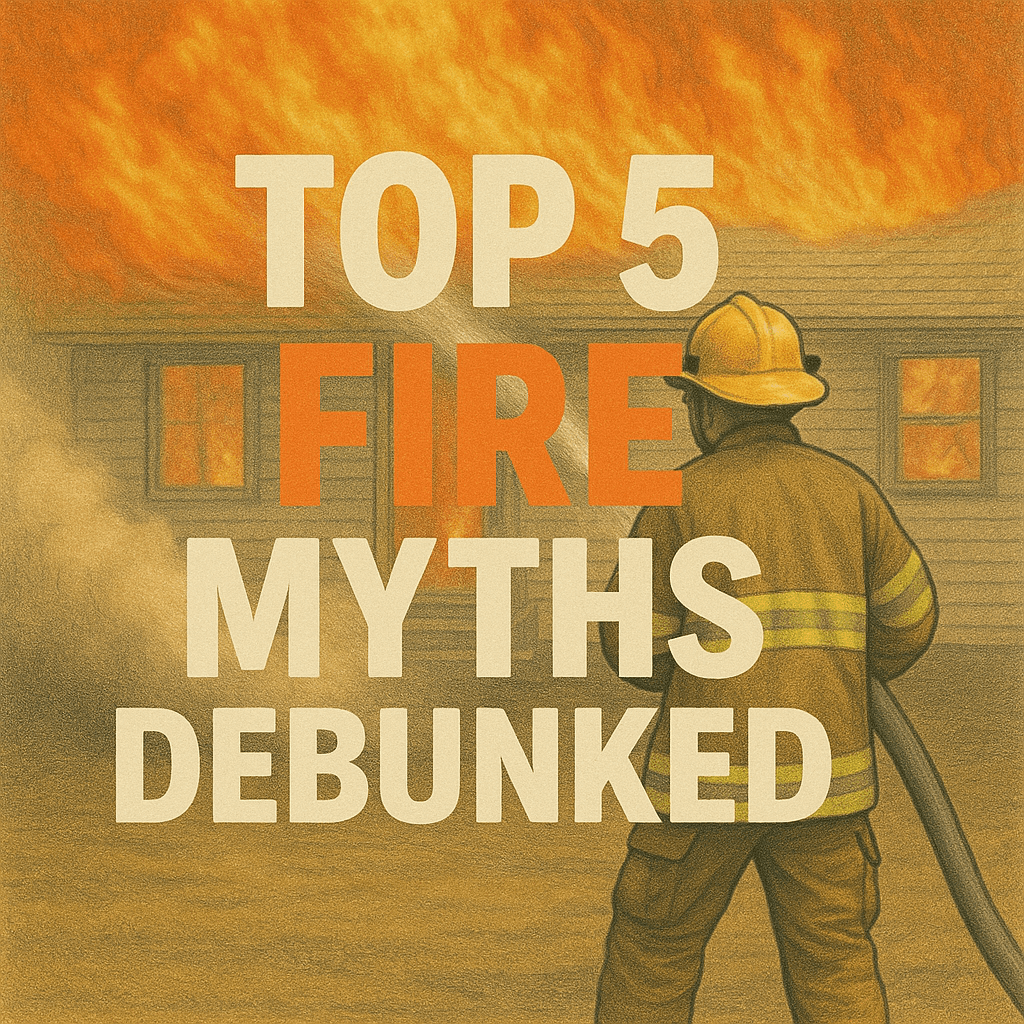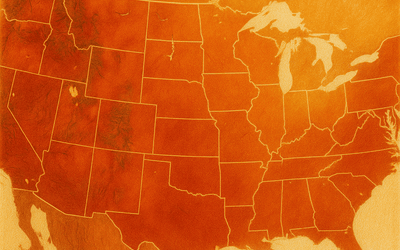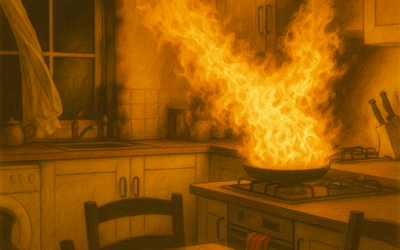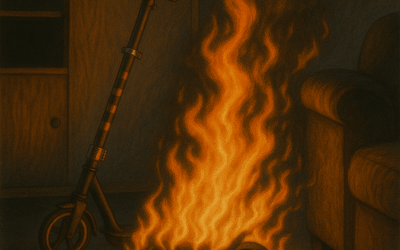Three weeks into my rookie year, I responded to a kitchen fire where the homeowner had tried to smother a grease fire with a wet towel. Bad idea. The towel caught fire, the homeowner panicked and threw it in the sink, and now we had burning grease spreading across the counter.
That call taught me something important: good intentions plus bad information equals bigger problems.
Twenty years later, I see the same pattern with fire blankets. People buy them thinking they're magic fire-stopping shields, then use them wrong when seconds count. The myths surrounding these tools can turn a simple kitchen mishap into a house fire.
Let me set the record straight on what fire blankets can and can't do. Your safety depends on getting this right.
What Fire Blankets Actually Do
Before we tackle the myths, you need to understand how fire blankets work. They're not complicated.
A fire blanket smothers flames by cutting off oxygen. Most are made from woven fiberglass treated with fire-resistant chemicals. The standard 39"x39" size covers most small fires you'll encounter at home. Larger sizes exist for commercial use, but the principle stays the same.
Think of fire like a campfire. Throw dirt on it, flames die. Same concept, different tool.
Fire blankets meet specific safety standards like EN 1869:2019 and UL 94-2016. These aren't just random numbers. They mean the blanket passed tests for heat resistance, flame spread, and durability. Always check for these certifications when shopping.
Myth #1: "A Fire Blanket Can Extinguish Any Type of Fire"
This myth kills me because it's so dangerous.
I've seen homeowners try to blanket electrical fires while the power was still on. I've watched someone attempt to smother a propane leak fire (spoiler: that just moves the problem). Not every fire responds to smothering.
The Reality Check
Grease Fires: This is where fire blankets shine, but only if you do it right. Small pan fires with contained oil? Perfect. But if that oil is spattering everywhere at 400°F, your blanket can become a flaming projectile. I learned this watching a cook try to blanket a deep fryer fire. The blanket caught fire before it even touched the oil.
Electrical Fires: Never, ever use a fire blanket on live electrical equipment. You're not just risking electrocution; you're also dealing with fires that can reignite from stored electrical energy. Turn off the power first, then consider your options.
Chemical Fires: Some chemicals burn differently than wood or fabric. Magnesium burns hot enough to decompose water into explosive hydrogen. A fire blanket won't stop that reaction and might trap heat, making things worse.
| Fire Type | Fire Blanket Effectiveness | Best Alternative |
|---|---|---|
| Small grease/oil fires | Excellent | Class K extinguisher for large amounts |
| Clothing fires | Excellent | Stop, drop, and roll |
| Live electrical fires | Dangerous | Turn off power, then Class C extinguisher |
| Flammable liquids (large spills) | Limited | Class B extinguisher |
| Chemical fires | Varies (often ineffective) | Specialized suppression systems |
The National Fire Protection Association provides clear guidance on fire blanket limitations. They recommend them for small, contained fires only.
Bottom Line: Fire blankets work great within their limits. Step outside those limits, and you're in trouble.
Myth #2: "You Can Reuse a Fire Blanket After One Use"
This myth probably started because fire blankets look so simple. They're just fabric, right? How much damage can one little fire do?
More than you think.
What Heat Does to Fire Blankets
I've examined dozens of used fire blankets during fire investigations. Even after "minor" incidents, the fiberglass weave shows damage. Heat breaks down the fire-resistant coating. The fabric becomes brittle. Most importantly, the structural integrity that makes them effective gets compromised.
Here's what happens during deployment:
- Temperatures can reach 1,000°F or higher
- Chemical treatments begin decomposing
- Fiberglass fibers start separating
- The blanket's ability to form an airtight seal deteriorates
You might not see visible damage, but the blanket's fire-stopping ability is shot.
The UL 94-2016 standard specifically addresses this. After exposure to fire, blankets must be replaced. Testing shows that reused blankets fail at much lower temperatures than fresh ones.
Safety Rule: One fire, one blanket. Period. I don't care if it looks fine. Replace it.
Myth #3: "Fire Blankets Never Expire"
I wish this were true. It would make my job easier.
Unfortunately, fire blankets age even when stored properly. The chemical treatments that make them fire-resistant break down over time. Humidity, temperature changes, and even UV exposure from overhead lights can accelerate this process.
The Science of Aging
Most manufacturers recommend replacing fire blankets every 5-10 years, depending on storage conditions. This isn't a money grab; it's based on real testing data.
Storage conditions matter:
- High humidity: Speeds chemical breakdown
- Temperature swings: Cause expansion and contraction that weakens fibers
- Direct sunlight: UV radiation breaks down protective coatings
- Contamination: Grease, dust, or chemicals can compromise effectiveness
I keep mine in a sealed pouch in a temperature-controlled area. Check the manufacturer's expiration date and set a phone reminder. Your life might depend on it working when you need it.
Storage Checklist
Monthly fire blanket inspection:
- CHECK expiration date
- INSPECT pouch for tears
- LOOK for discoloration
- FEEL for brittle spots
- VERIFY easy access
- CLEAN surrounding area
- TEST release tabs
Myth #4: "Anyone Can Deploy a Fire Blanket Correctly in a Panic"
This myth drives me crazy because it's so wrong and so dangerous.
I've trained hundreds of people in fire response. Even with practice, stress makes people do stupid things. I've watched trained firefighters make mistakes under pressure. Expecting untrained civilians to perform flawlessly during their first real emergency is unrealistic.
What Panic Does to Decision-Making
When you see flames, your brain floods with adrenaline. Fine motor skills disappear. Complex thinking shuts down. You default to whatever you've practiced most.
Common panic-induced mistakes I've witnessed:
- Throwing the blanket instead of placing it carefully
- Failing to protect hands and arms during deployment
- Not sealing edges, allowing oxygen to feed the fire
- Removing the blanket too soon, causing reflash
- Standing in the wrong position and getting burned
The U.S. Fire Administration emphasizes the importance of fire safety training and practice. They recommend regular drills for all fire safety equipment.
The Right Way to Deploy
Here's the technique I teach new firefighters:
- Pull the tabs: Grab the release tabs and pull straight down. Don't yank; the blanket needs to unfold properly.
- Protect yourself: Wrap the top corners around your hands and forearms. This shields you from radiant heat.
- Approach low: Stay below the heat plume. Fire and hot gases rise.
- Deploy near to far: Place the near edge down first, then roll it over the fire. This prevents pushing flames toward you.
- Seal the edges: Make sure the blanket covers completely with no gaps.
- Leave it alone: Wait at least 30 minutes before removing. Reflash can happen quickly.
Practice this monthly. Use an unlit pan on your stove. Time yourself. Make it muscle memory.
You can learn more about proper fire blanket deployment techniques in our detailed guide.
Myth #5: "Fire Blankets Are a Substitute for Fire Extinguishers"
This myth bothers me because it creates a false choice. You need both tools, not one or the other.
Fire blankets and extinguishers serve different purposes. Thinking they're interchangeable is like saying a hammer can replace a screwdriver because they're both tools.
Fire Extinguisher Advantages
Extinguishers work at a distance. You can attack a fire from 6-8 feet away instead of getting close enough to touch it. They're faster for larger fires and work on multiple fire types if you have the right classification.
But here's something most people don't know: many fire extinguishers contain PFAS chemicals (per- and polyfluoroalkyl substances). These "forever chemicals" don't break down naturally and accumulate in your body over time. Studies link PFAS exposure to cancer, liver damage, decreased fertility, and increased risk of asthma and thyroid disease.
When you discharge a PFAS-containing extinguisher indoors, you're coating your kitchen, your food prep areas, and everything else with these persistent toxins. The cleanup costs can reach thousands of dollars. Some insurance companies are starting to exclude PFAS contamination cleanup from standard policies.
Fire Blanket Advantages
Fire blankets leave no chemical residue. Zero cleanup beyond removing the used blanket. No toxic exposure. No insurance complications.
They're also completely silent, which matters more than you might think. I've responded to calls where the sound of an extinguisher discharging woke a sleeping baby during a minor kitchen fire. Sometimes quiet suppression is better.
For clothing fires, blankets win hands down. You can't spray someone with an extinguisher without causing injury, but you can safely wrap them in a fire blanket.
| Scenario | Best Tool | Why |
|---|---|---|
| Small pan fire | Fire blanket | No chemicals, easy cleanup |
| Large kitchen fire | Class K extinguisher | Better range and capacity |
| Clothing fire | Fire blanket | Safe for human contact |
| Electrical fire | Class C extinguisher | Works at safe distance |
| Unknown fire type | ABC extinguisher | Covers multiple fire classes |
Smart Strategy: Keep both within reach. Start with the blanket for small, contained fires. Escalate to the extinguisher if the blanket isn't working or the fire is too large.
Other Common Misconceptions
Bigger Is Always Better
Not necessarily. A 40"x60" blanket sounds impressive, but can you actually deploy it correctly? The standard 39"x39" size exists for good reasons. It's large enough to cover most home fires but small enough for one person to handle effectively.
Oversized blankets can be harder to deploy quickly and accurately. In fire response, speed and precision matter more than raw coverage area.
All Fire Blankets Are the Same
Absolutely not. Material quality, weave density, and chemical treatments vary significantly between manufacturers. Cheap blankets might meet basic standards but fail when you need them most.
Look for blankets that exceed minimum requirements. The difference in cost is minimal compared to potential fire damage. You can read about the differences between fire blanket types in our comparison guide.
Fire Blankets Work on Gas Fires
This is extremely dangerous thinking. If you have a gas leak fire, your priority is shutting off the gas supply, not smothering the flames. Extinguishing a gas fire without stopping the gas flow creates an explosion risk from accumulated gas vapors.
Call the fire department immediately for any suspected gas fire.
Choosing the Right Fire Blanket
Not all fire blankets are created equal. Here's what I look for:
Certification Standards
Verify these markings on any blanket you consider:
- EN 1869:2019: European standard for fire blanket performance
- UL 94-2016, V-0: Underwriters Laboratories flammability rating
- AS/NZS 3504:2006: Australian/New Zealand standard
- BSEN 1869:1997: British standard (older but still valid)
These aren't just random numbers. They represent real testing under controlled conditions.
Material Considerations
Most quality blankets use woven fiberglass with fire-resistant treatments. Some newer options use silicone-coated materials. Both have advantages:
Traditional Fiberglass: Proven technology, cost-effective, meets all safety standards. The 39"x39" size covers most residential needs perfectly.
Silicone Options: May offer better heat resistance and easier cleanup in some situations. However, they're typically more expensive and not necessarily better for home use.
Don't get caught up in material marketing. Focus on certifications and proper sizing for your needs.
Proper Maintenance and Storage
Fire blankets require minimal maintenance, but "minimal" doesn't mean "none."
Monthly Checks
- Visual inspection: Look for tears, discoloration, or damage to the storage pouch
- Access check: Make sure nothing blocks easy retrieval
- Date verification: Confirm you're within the recommended replacement timeframe
- Family awareness: Ensure everyone knows where it is and how to use it
Ideal Storage Conditions
- Temperature range: 32°F to 100°F
- Humidity below 70%
- Away from direct sunlight
- Protected from grease and chemical contamination
- Easily accessible during emergencies
Mount your blanket in a clearly marked location at eye level. I recommend near the stove but not directly above it where heat and grease can cause degradation.
For detailed maintenance schedules, check out our comprehensive maintenance guide.
When NOT to Use a Fire Blanket
Knowing when not to use a fire blanket is just as important as knowing when to use one. These situations require different approaches:
- Large fires: Anything bigger than a stovetop burner
- Spreading fires: If flames are already moving beyond the original source
- Overhead fires: Never try to blanket fires above your head
- Windy conditions: Outdoor use in wind can spread flames
- Multiple ignition sources: Blankets only work on single-point fires
In these situations, evacuate and call 911. Your life is worth more than any property.
Our guide on when to avoid fire blankets covers additional scenarios to consider.
Training Your Family
The best fire blanket in the world won't help if your family doesn't know how to use it.
Practice Scenarios
Run through these situations with your family:
- Kitchen fire drill: Practice the deployment steps using a cold pan
- Clothing fire response: Learn the wrap-and-roll technique
- Emergency communication: Who calls 911? When?
- Evacuation routes: Multiple ways out of every room
Make it age-appropriate. Kids need to know where the blanket is and when to get adult help, not how to fight fires themselves.
Regular Refreshers
Schedule family fire safety reviews twice a year. I recommend when you change your clocks for daylight saving time. Review procedures, check equipment, and practice scenarios.
Muscle memory saves lives when panic takes over.
What Really Matters
After two decades of fighting fires, I've learned that preparation beats panic every time. Fire blankets are excellent tools when used correctly, but they're not magic shields that solve every fire problem.
The myths we've covered kill people. They create false confidence that leads to poor decisions during emergencies. Don't let marketing hype or internet rumors guide your fire safety planning.
Here's what actually works:
- Understand your tools' limitations
- Practice deployment techniques regularly
- Maintain equipment properly
- Plan for multiple scenarios
- Train your entire family
A quality fire blanket can save your life, your home, and thousands in cleanup costs. But only if you know what you're doing.
Want to see our recommended fire blankets? Check out our emergency fire blanket that meets all safety standards we've discussed.
Stay safe out there. Your family is counting on you to get this right.






